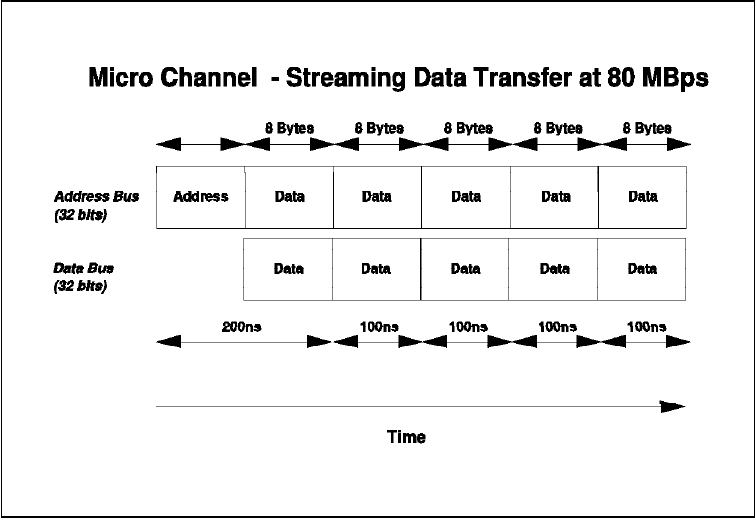Specifications
Table Of Contents
- IBM PC Server and Novell NetWare Integration Guide
- Abstract
- Contents
- Figures
- Tables
- Special Notices
- Preface
- Chapter 1. IBM PC Server Technologies
- Processors
- Clock Rate
- External Interfaces
- Processor Types
- Multiprocessing
- Memory
- Caches
- Memory Interleaving
- Dual Path Buses
- SynchroStream Technology
- Memory Error Detection and Correction
- Standard (Parity) Memory
- Error Correcting Code (ECC)
- Error Correcting Code- Parity Memory (ECC- P)
- ECC on SIMMs (EOS) Memory
- Performance Impact
- Memory Options and Speed
- Bus Architectures
- ISA Bus
- EISA Bus
- Micro Channel Bus
- PCI Bus
- Disk Subsystem
- Hard Disk Interfaces
- SCSI Technology
- SCSI Adapters
- Hard Disk Drives
- RAID Technology
- RAID Classifications
- Recommendations
- LAN Subsystem
- Shared RAM Adapters
- Bus Master Adapters
- PeerMaster Technology
- Security Features
- Tamper- Evident Cover
- Secure I/ O Cables
- Passwords
- Secure Removable Media
- Selectable Drive Startup
- Unattended Start Mode
- Systems Management
- DMI
- SNMP
- NetFinity
- SystemView
- Fault Tolerance
- NetWare SFT III
- Uninterruptible Power Supply (UPS)
- APC PowerChute
- Chapter 2. IBM PC Server Family Overview
- Chapter 3. Hardware Configuration
- The Setup Program
- Main Menu
- Advanced Menu
- Security
- EISA Configuration Utility
- SCSI Select Utility Program
- System Programs
- Starting From the System Partition
- Starting From the Reference Diskette
- Main Menu Options
- Backup/ Restore System Programs Menu
- Set Configuration Menu
- Set Features Menu
- Test the Computer
- More Utilities Menu
- Advanced Diagnostic Program
- RAID Controller Utility
- Drive Information
- Formatting the Disks
- Defining a Hot- Spare Disk
- Creating a Disk Array
- Defining Logical Drives
- Setting the Write Policy
- Initializing the Array
- Backup/ Restoring the Configuration
- Chapter 4. Novell NetWare Installation
- ServerGuide Overview
- Starting ServerGuide
- Installing NetWare 4.1 with ServerGuide
- Installing NetWare 3.12 with Diskettes
- Hardware Requirements
- Software Requirements
- Information Requested at Time of Installation
- Installation Files
- Installation Procedure
- Installing NetWare 4.1 with the Original CD- ROM
- Hardware Requirements
- Software Requirements
- Installation Procedure
- NetFinity Services for NetWare
- System Requirements
- Installing NetFinity Services for NetWare
- The RAID Administration for NetWare Utility
- Installing the Utility
- Hard Disk Failure Simulation
- Simulating with a Hot Spare Drive
- Simulating without a Hot Spare Drive
- Chapter 5. Performance Tuning
- Appendix A. EISA Configuration File
- Appendix B. Hardware Compatibility, Device Driver, and Software Patch Information
- Appendix C. Configuring DOS CD-ROM Support
- List of Abbreviations
- Index
- Special Characters C
- Numerics
- A
- B
- D
- E
- F
- H
- M
- I
- N
- K
- L
- O
- P
- S
- Q
- R
- T
- U
- V
- W
- Z
- ITSO Technical Bulletin Evaluation RED000

The Micro Channel supports another mode of data streaming whereby the
address bus can also be used to transfer data. This is depicted in Figure 9 on
page 15.
Figure 9. Micro Channel - Data Streaming Transfer (80 MBps)
As can be seen from this figure, in this mode, after the initial address is
presented during the first bus cycle, the address bus is then multiplexed to carry
an additional 32 bits of data. This results in an effective data transfer rate of 80
MBps.
Data streaming, as well as improving the data transfer rate, also provides a
more efficient use of the Micro Channel. Since MCA operations complete in a
shorter amount of time, the overall throughput of the system is increased.
Data streaming is useful for any adapters that perform block transfers across the
Micro Channel such as the IBM SCSI-2 Fast/Wide Streaming RAID Adapter/A.
MCA is implemented in some models of the IBM PC Server 300 and 500 lines
and in all models of the PC Server 720.
1.5.4 PCI Bus
In the later part of 1992, Intel, IBM and a number of other companies worked
together to define a new local component bus which was designed to provide a
number of new features and work with a wide range of new processors. The
result was the Peripheral Component Interconnect (PCI) bus. The PCI bus was
designed to provide the Pentium processor with all the bandwidth it needed and
to provide for more powerful processors in the future. It was also designed for
use in multiprocessing environments.
The PCI bus was designed to work with a number of buses including Micro
Channel, ISA and EISA buses. It was designed to provide a local bus, more
tightly integrated with the processor, to provide more bandwidth to I/O devices
such as LAN adapters and DISK controllers, which require more bandwidth than
Chapter 1. IBM PC Server Technologies 15










